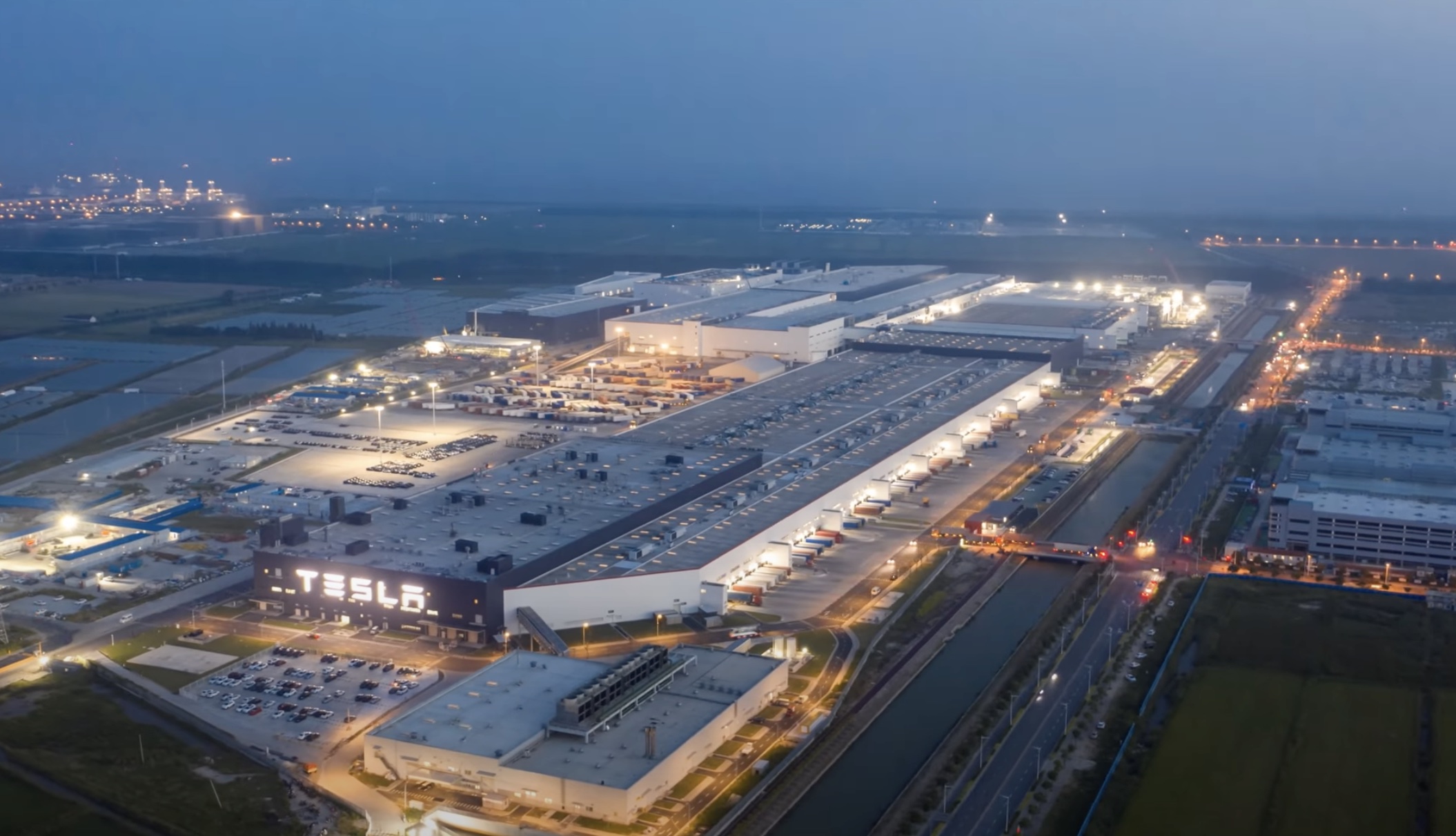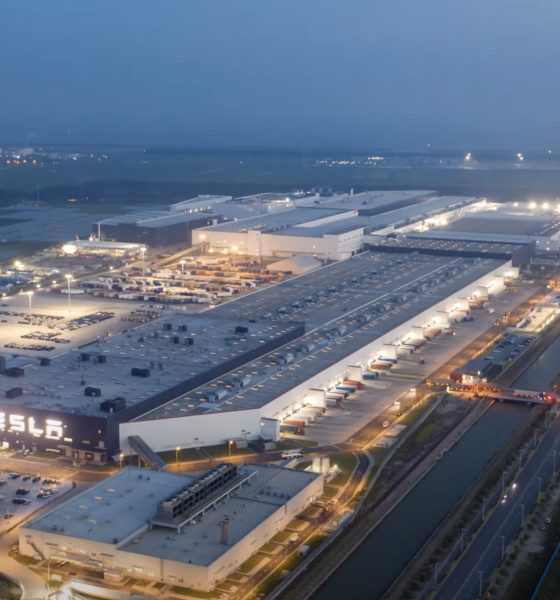

News
Tesla Giga Shanghai to take two-day break amid China’s fresh wave of Covid cases
Tesla’s primary vehicle export hub, Gigafactory Shanghai, is suspending its operations for two days. The halt comes as China deals with its latest Covid outbreak, which has forced the country to adopt stringent safety restrictions once more. The temporary pause in the massive electric vehicle production facility’s operations was shared in a notice sent internally and to the company’s suppliers.
Considering that Gigafactory Shanghai operates around the clock, the loss of two days’ worth of production would likely result in the company missing some of its output for this month. Provided that the facility could resume operations without delays following the two-day shutdown, Giga Shanghai may be able to match or perhaps slightly exceed its numbers from last month. Tesla China delivered 56,515 vehicles, including 33,315 that were exported, in February 2022.
The notice, which was sent on Wednesday and reviewed by Reuters, stated that the pause in Gigafactory Shanghai would last from Wednesday to Thursday. The notice did not specify the reason behind the facility’s shutdown, and the document did not specify if the shutdown would affect all of the plant’s operations. Two individuals who were reportedly briefed on the notice, however, stated that they believe the halt applies to Giga Shanghai’s general assembly lines.
Another notice, this one sent to Tesla’s suppliers in China, inquired how many workers were needed to achieve full production. The notice also asked suppliers to provide details on how their workers are being affected by China’s tightening Covid restrictions. A work setup similar to what was adopted by Apple supplier Foxconn — which involves workers temporarily living in factories — was also mentioned by the electric vehicle maker. It should be noted that the Apple supplier was able to resume operations at its Shenzhen campus on Wednesday after it adopted the arrangement.
China is currently dealing with what could very well be described as the worst Covid outbreak that the country has faced in two years, thanks in part to the Omicron BA.2 subvariant, which is about 30% more transmissible than the initial Omicron BA.1 strain. Factories have been shut down across the country, and in Shanghai, authorities have asked numerous residents to remain in their homes or workplaces for 48 hours to as long as 14 days. This time would be used to conduct necessary Covid tests and implement contact tracing.
Gigafactory Shanghai currently plays a key role in Tesla’s operations, being the facility that supplies Model 3 and Model Y vehicles to foreign territories in Asia and Europe. Last year alone, the facility accounted for about half of the 936,000 vehicles that Tesla delivered globally, and that’s with the Model Y line being ramped for several months. Reports have since emerged stating that Tesla is looking to double its output in China by adding a new vehicle production facility in the vicinity of Giga Shanghai. Once the new plant is operational, estimates suggest that Tesla China could produce about 2 million vehicles annually on its own.
Don’t hesitate to contact us with news tips. Just send a message to simon@teslarati.com to give us a heads up.

News
Tesla FSD fleet is nearing 7 billion total miles, including 2.5 billion city miles
As can be seen on Tesla’s official FSD webpage, vehicles equipped with the system have now navigated over 6.99 billion miles.

Tesla’s Full Self-Driving (Supervised) fleet is closing in on almost 7 billion total miles driven, as per data posted by the company on its official FSD webpage.
These figures hint at the massive scale of data fueling Tesla’s rapid FSD improvements, which have been quite notable as of late.
FSD mileage milestones
As can be seen on Tesla’s official FSD webpage, vehicles equipped with the system have now navigated over 6.99 billion miles. Tesla owner and avid FSD tester Whole Mars Catalog also shared a screenshot indicating that from the nearly 7 billion miles traveled by the FSD fleet, more than 2.5 billion miles were driven inside cities.
City miles are particularly valuable for complex urban scenarios like unprotected turns, pedestrian interactions, and traffic lights. This is also the difference-maker for FSD, as only complex solutions, such as Waymo’s self-driving taxis, operate similarly on inner-city streets. And even then, incidents such as the San Francisco blackouts have proven challenging for sensor-rich vehicles like Waymos.
Tesla’s data edge
Tesla has a number of advantages in the autonomous vehicle sector, one of which is the size of its fleet and the number of vehicles training FSD on real-world roads. Tesla’s nearly 7 billion FSD miles then allow the company to roll out updates that make its vehicles behave like they are being driven by experienced drivers, even if they are operating on their own.
So notable are Tesla’s improvements to FSD that NVIDIA Director of Robotics Jim Fan, after experiencing FSD v14, noted that the system is the first AI that passes what he described as a “Physical Turing Test.”
“Despite knowing exactly how robot learning works, I still find it magical watching the steering wheel turn by itself. First it feels surreal, next it becomes routine. Then, like the smartphone, taking it away actively hurts. This is how humanity gets rewired and glued to god-like technologies,” Fan wrote in a post on X.
News
Tesla starts showing how FSD will change lives in Europe
Local officials tested the system on narrow country roads and were impressed by FSD’s smooth, human-like driving, with some calling the service a game-changer for everyday life in areas that are far from urban centers.

Tesla has launched Europe’s first public shuttle service using Full Self-Driving (Supervised) in the rural Eifelkreis Bitburg-Prüm region of Germany, demonstrating how the technology can restore independence and mobility for people who struggle with limited transport options.
Local officials tested the system on narrow country roads and were impressed by FSD’s smooth, human-like driving, with some calling the service a game-changer for everyday life in areas that are far from urban centers.
Officials see real impact on rural residents
Arzfeld Mayor Johannes Kuhl and District Administrator Andreas Kruppert personally tested the Tesla shuttle service. This allowed them to see just how well FSD navigated winding lanes and rural roads confidently. Kruppert said, “Autonomous driving sounds like science fiction to many, but we simply see here that it works totally well in rural regions too.” Kuhl, for his part, also noted that FSD “feels like a very experienced driver.”
The pilot complements the area’s “Citizen Bus” program, which provides on-demand rides for elderly residents who can no longer drive themselves. Tesla Europe shared a video of a demonstration of the service, highlighting how FSD gives people their freedom back, even in places where public transport is not as prevalent.
What the Ministry for Economic Affairs and Transport says
Rhineland-Palatinate’s Minister Daniela Schmitt supported the project, praising the collaboration that made this “first of its kind in Europe” possible. As per the ministry, the rural rollout for the service shows FSD’s potential beyond major cities, and it delivers tangible benefits like grocery runs, doctor visits, and social connections for isolated residents.
“Reliable and flexible mobility is especially vital in rural areas. With the launch of a shuttle service using self-driving vehicles (FSD supervised) by Tesla in the Eifelkreis Bitburg-Prüm, an innovative pilot project is now getting underway that complements local community bus services. It is the first project of its kind in Europe.
“The result is a real gain for rural mobility: greater accessibility, more flexibility and tangible benefits for everyday life. A strong signal for innovation, cooperation and future-oriented mobility beyond urban centers,” the ministry wrote in a LinkedIn post.
News
Tesla China quietly posts Robotaxi-related job listing
Tesla China is currently seeking a Low Voltage Electrical Engineer to work on circuit board design for the company’s autonomous vehicles.

Tesla has posted a new job listing in Shanghai explicitly tied to its Robotaxi program, fueling speculation that the company is preparing to launch its dedicated autonomous ride-hailing service in China.
As noted in the listing, Tesla China is currently seeking a Low Voltage Electrical Engineer to work on circuit board design for the company’s autonomous vehicles.
Robotaxi-specific role
The listing, which was shared on social media platform X by industry watcher @tslaming, suggested that Tesla China is looking to fill the role urgently. The job listing itself specifically mentions that the person hired for the role will be working on the Low Voltage Hardware team, which would design the circuit boards that would serve as the nervous system of the Robotaxi.
Key tasks for the role, as indicated in the job listing, include collaboration with PCB layout, firmware, mechanical, program management, and validation teams, among other responsibilities. The role is based in Shanghai.
China Robotaxi launch
China represents a massive potential market for robotaxis, with its dense urban centers and supportive policies in select cities. Tesla has limited permission to roll out FSD in the country, though despite this, its vehicles have been hailed as among the best in the market when it comes to autonomous features. So far, at least, it appears that China supports Tesla’s FSD and Robotaxi rollout.
This was hinted at in November, when Tesla brought the Cybercab to the 8th China International Import Expo (CIIE) in Shanghai, marking the first time that the autonomous two-seater was brought to the Asia-Pacific region. The vehicle, despite not having a release date in China, received a significant amount of interest among the event’s attendees.








